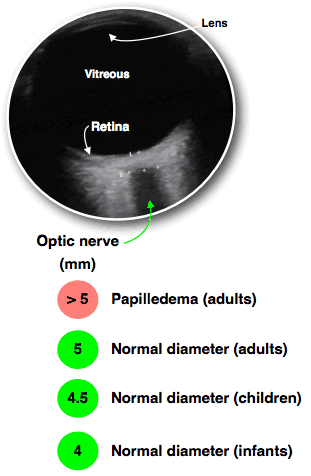New Boost Exam: Fundamentals of Clinical Ultrasound for PAs

The use of point-of-care ultrasound (POCUS) is now common practice in the clinical setting.
Get a high-yield review of the most commonly encountered POCUS scans including abdominal, ocular, cardiac, pelvic, thoracic, vascular, cutaneous, and FAST ultrasounds with our new Boost Exam: Fundamentals of Clinical Ultrasound.
Here is a sample question from the module:
Which of the following measurements can be used as a marker to assess for the presence of increased intracranial pressure?
A. Intraocular pressure
B. Optic nerve sheath diameter
C. Posterior chamber depth
D. Retinal thickness
Answer B
Ocular ultrasound can be used in the emergency setting to aid in the evaluation of globe trauma, vitreous hemorrhage, intraocular foreign bodies, and retinal detachment. It has also been found to be an easy method of assessing intracranial pressure. A normal optic nerve sheath diameter is up to 5 mm in adults, 4.5 mm in children, and 4.0 mm in infants. Using a high-resolution linear array transducer, the diameter of the optic nerve sheath is measured 3 mm behind the globe. The average of 3 measurements is taken for each eye. An optic nerve sheath diameter > 5 mm in adults predicts an intracranial pressure of > 20 mm Hg with a sensitivity and specificity of 88–94% and 76–93% respectively.

Elevated intraocular pressure (A) can be seen in acute glaucoma but does not correlate with intracranial pressure. Posterior chamber depth (C) can be decreased in the setting of a ruptured globe. An increase in retinal thickness (D), indicating macular edema, can be due to numerous causes such as diabetes, uveitis, and retinal vein occlusion but does not correlate with increased intracranial pressure.
One Step Further question: What is the sensitivity of detecting retinal detachment by ocular ultrasound?
Answer: 97–100% when performed by an emergency physician.
Sign up for a free trial account to access the Fundamentals of Clinical Ultrasound. If you already have an account, sign in and go to your Boost Box and locate the Boost Exam “Fundamentals of Clinical Ultrasound.” You may also be interested in other resources such as Rotation Exams, PANCE Review, Didactic Qbank, or PANRE review.





Comments (0)